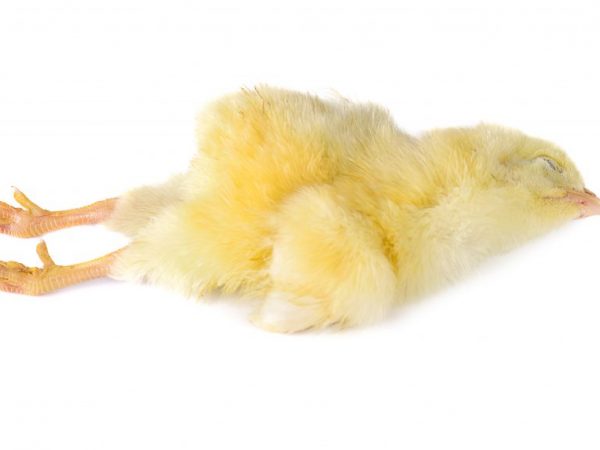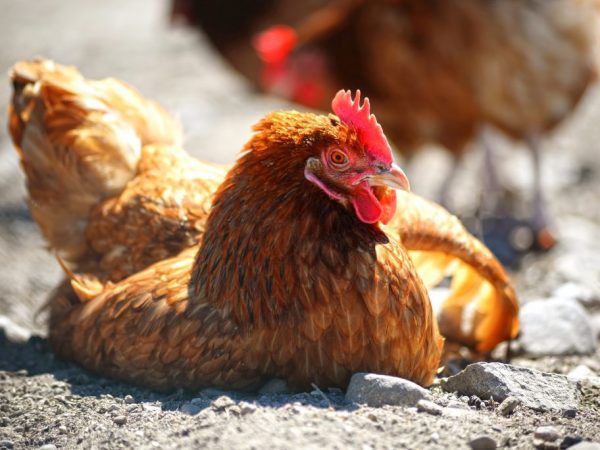Symptoms of marek's disease in chickens
When breeding poultry, breeders often have to deal with various diseases. Marek's disease in chickens is one of the most common and dangerous. Knowing all the symptoms, methods of treatment and prevention, you will be able to maintain the health and productivity of your livestock at the highest level.

Symptoms of marek's disease in chickens
Varieties
Marek's disease is caused by a viral infection that affects the central nervous system and internal organs of the bird. This sore has three types, depending on the extent of the lesion.
- Neural. Nerve cells are damaged, resulting in paralysis and paresis.
- Ocular. The virus infects the eyeball and retina, resulting in complete blindness.
- Visceral. Internal organs become covered with tumors.
Signs of ailment
The disease is subdivided into two stages with different symptoms and period of the course.
Sharp
In its acute form, the virus spreads rapidly and infects all livestock within a short period of time, ranging from one to two weeks.
In chickens, there is a significant decrease in productivity, tumors form on the internal organs.
At this stage, the risk of death is high.
The symptoms of the disease are similar to leukemia:
- violation of the digestive tract;
- the bird refuses food and quickly loses weight;
- the state is sluggish, depressed;
- in individuals with low immunity, paralysis and paresis are noted.
Chronic (classic)
With the development of a chronic disease, the virus affects the nervous system and eyes, but the probability of death is only 30%.
The symptoms are as follows:
- the bird begins to limp;
- sagging wings and tail;
- the neck is twisted;
- in weak individuals, paralysis of some parts of the body is noted;
- vision deteriorates - the pupil narrows or vice versa becomes large, pear-shaped, the iris acquires a gray or bluish tint, there is no reaction to light.
Reasons for defeat
Several factors contribute to the development of the disease:
- the age of the bird - older individuals and young animals are more likely to be affected;
- heredity - the presence in the body of antibodies that were passed on from the mother;
- an increased amount of pathogenic microflora in the body;
- strain of the virus;
- low activity of the immune system.
The incubation period lasts from 2 weeks to 5 months - it is always individual and depends on the general immunity of the bird.
Infection routes

Chickens become infected from each other by airborne droplets
Marek's disease in chickens is transmitted by airborne droplets. The source of infection is a sick individual, which, when exhaled, releases pathogenic flora into the air.
It enters the body of healthy birds through the respiratory tract, gastrointestinal tract and feather follicles.
The virus also spreads through food, water, bedding and dust. Insects parasitizing the skin and plumage, such as ticks, beetles, chewing lice and flies, can become carriers.
Immediately after infection, the sick individual behaves unchanged and its condition does not change, within a week it is an active carrier of the virus.
Disease development
The very first symptoms begin to appear only 4-5 weeks after the illness.
Chickens with strong immunity can serve as a source of infection for healthy individuals from 16 to 24 months. At the same time, it does not show any signs of the disease - this is the special danger of a viral infection of the marek, all the livestock becomes infected imperceptibly.
The virus that has entered the circulatory system is localized in the lymph, affecting muscle tissue, eyes and internal organs.
With a severe defeat, the sick individual dies. If the bird has a strong immune system, after proper treatment, a complete recovery occurs.
Disease in broilers
Veterinarians report a high percentage of damage among broilers. The risk group includes broiler chickens from 1 to 7 days old.
The bottom line is that the disease manifests itself too late, sometimes it is possible to determine the infection after 2-3 months and it is extremely rare to save such individuals.
The main symptoms of infection:
- a sharp decrease in body weight;
- lethargy, inactivity;
- the pupil changes shape - it becomes oval or very small;
- the neck turns onto its side;
- the body is dehydrated.
Diagnosis of the disease
It is possible to diagnose this ailment after an autopsy - there are numerous tumors on the internal organs, the nerve trunks are thickened, the skin and muscles are affected. A piece of tissue is taken from each part of the body for virological examination.
After recovery, the bird acquires immunity from this sore, the risk of re-infection is minimal. Chickens who are vaccinated on time and correctly can become infected, but they carry the disease in a mild form.
There is no risk of human infection from a sick chicken, however, eating the meat of a sick individual is allowed provided there are no signs:
- damage to internal organs;
- jaundice;
- changes in the skin and muscles;
- anemia.
Before eating, meat must be heat treated for at least 1.5 hours.
Treatment methods
Marek's disease can only be cured in adult chickens and at an early stage of infection. Antiviral drugs are used. But even with careful care and adherence to all the rules of treatment, the probability of death of the bird remains high.
For cure, Acyclovir is used. Scheme and dosage: 1 capsule (200 mg) is given every day for 2 days. The next week - ½ tablet.
Then another 5 days, sick individuals are given Bifidumbacterin - half the dose. A sign of recovery is the blanching of the scallop and numerous rashes of herpes on its surface.
During the treatment period, chickens often refuse food, so they need to be fed with a syringe with liquid mash. If you do not give food, the bird will wither and die.
After the first signals of improvement in the condition, complete healing occurs in 15-20 days.
Grafting
The main way to protect yourself from damage is timely vaccination. The injections include immunological drugs that promote the development of immunity against virus strains. They are injected into the muscle of young animals at the age of 1-2 days.
Several remedies are used against infection with marek's disease:
- VNIIZ;
- Intervet, Nobilis;
- liquid injections from the Shchelkino biocombine and the Kursk biofactory;
- foreign drugs - Rispens, Marex and Vaxitec.
After vaccination, the degree of protection is quite high and amounts to 90%. Within 10 days, the chickens fully develop immunity against this disease.
Possible side effects are drowsiness, lethargy. For 2-3 days, the young are kept in a warm room to eliminate the risk of colds.
Additional prevention
In addition to timely vaccination, veterinarians recommend observing simple sanitary and hygienic measures in keeping the livestock.
- Distribute birds by age and keep in different rooms. Youngsters are separated from adult chickens and are given special care and attention.
- Newly acquired individuals need to be quarantined.
- For any symptoms of viral, bacterial and fungal infections, a separate place is allocated for sick chickens.
- In case of damage to poultry, the sale of chicks and eggs is prohibited. The process of breeding new offspring is suspended until the moment of complete recovery of the livestock. The incubator in which the chicks were hatched must be thoroughly disinfected. The chicken coop and all the accessories for the maintenance are disinfected with alkali, chlorine, phenol or formaldehyde.
- During the period of infection of individual individuals, daily examination of healthy chickens for damage is needed. Newly infected adults or young females are discarded.
If more than 10% are affected by the marek virus, all livestock are allowed to slaughter. After that, the chicken coop is sterilized, the subsequent settlement of a new batch is allowed in a month.


